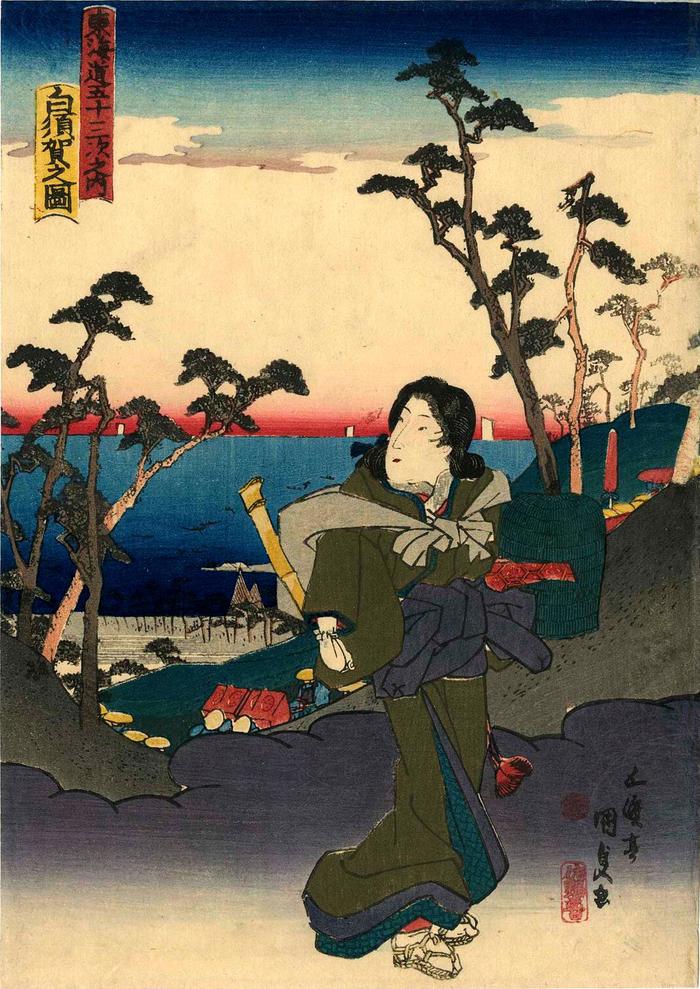Utagawa Kunisada (歌川国貞) / Toyokuni III (三代豊国) (artist 1786 – 01/12/1865)
View of Shirasuka (Shirasuka no zu: 白須賀之図) from the chuban series Fifty-three Stations of the Tōkaidō Road (Tōkaidō gojūsan tsugi no uchi: 東海道五十三次之内)
ca 1838
7 in x 9.75 in (Overall dimensions) Japanese woodblock print
Signed: Kōchōrō Kunisada ga (香蝶楼国貞画)
Publisher: Sanoya Kihei
Censor's seal: kiwame
Museum of Fine Arts, Boston - published by both Moriya Jihei and Sanoya Kihei
National Diet Library - published by Moriya Jihei and Sanoya Kihei
Spencer Museum of Art - published by Moriya Jihei
Museum für angewandte Kunst, Vienna
British Museum - Hiroshige's 'Shirasuka Shiomizaka zu' version
Virginia Museum of Fine Art
Ishikawa Prefectural Museum of Art - they date their copy to 1836
Bryn Mawr
Honolulu Museum of Art - published by Moriya Jihei
Nationaal Museum van Wereldculturen (Rijksmuseum Volkenkunde, Leiden) - via Ritsumeikan University
Google maps - the Shirasuka district In Hokusai and Hiroshige: Great Japanese Prints from the James A. Michener Collection, Honolulu Academy of Arts on page 196 it says: "The [Hiroshige] print depicts a slope that rises to the right in the foreground. Shirasuka station was previously located near the beach called Sakanoshita (Lower Slope), but was relocated to the uplands to avoid tsunamis..."
****
This print is number 33 in this series. The curatorial files at X say: "In the foreground a woman dressed in the manner of a komusō. The woman has wrapped a shawl around her shoulders, which she uses to carry her luggage on her back. Komusō 虚無 僧 were originally wandering monks. Later the men disguised themselves who wanted to move unrecognized in the joyous quarters, gladly as komusō, since the basket-like straw hat that conceals the face is part of their appearance. In addition to such a straw hat, the characteristics of these clothes are: the simple kimono, a thick black belt with a kind of pocket in the back and a bamboo flute (shakuhachi 尺八)."
Kunisada's chuban Bijin Tōkaidō (東海道美人) series was first published around 1833, after Hiroshige's famous series was underway but not yet complete.
****
In Tokaido Landscapes: The Path from Hiroshige to Contemporary Artists, 2011, #33, p. 45, speaking of the original Hiroshige print it says in a text by Sasaki Moritoshi: "The setting is the Shiomi Slope, famous for its lovely view of he sea (a treacherous stretch of the Pacific Ocean known as Enshū Nada). A daimyo's procession is coming down the slope on its way to Edo."
Later in this volume is a set of prints by Munakata Shiko with his versions of the Tōkaidō Road. He wrote of Shirasuka: "If we travel from Kyoto along the Tōkaidō, this is the first spot from which to see the sea. Hiroshige saw the sea from above, but I took the opposite viewpoint, seeing it from the sea level. In this composition, seeing it from sea level. In this composition, the sky is high, the sea is blue, and the seashore pines boast exquisitely shaped branches. However, I though that not enough, so I added two airplanes, which tightened the whole scenery."
****
In Tōkaidō Texts and Tales: Tōkaidō gojūsan tsui by Kuniyoshi, Hiroshige, and Kunisada, edited by Andreas Marks, University Press of Florida, 2015, it says about the print dealing with Shirasuka cartouche on page 108 says: "Onnaya is to be found in Higashi-Hashimoto, in Shirasuka. This was an old post town, and contains the ruins of the inn visited by Yoritomo on his way to the capital in the first year of Kenkyū (1190). On the occasion of Yoritomo's visit, the headman of Hashimoto had a flock of prostitutes come to wait upon him at the inn. Thus the origins of the name Onnaya (Valley of Women). A woman favored by Yoritomo's affections at that time turned to a life of chastity and became a nun once she heard of his death. She took the Buddhist name Myōshō and erected a temple where she practiced austerity for many years. The Kyōon Temple located in present-day Hashimoto is that temple."
****
Illustrated in a small color reproduction in Kunisada's Tokaido: Riddles in Japanese Woodblock Prints by Andreas Marks, Hotei Publishing, 2013, page 71, T24-33.
Sanoya Kihei (佐野屋喜兵衛) (publisher)
landscape prints (fūkeiga 風景画) (genre)
